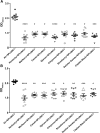Tobacco exposure inhibits SPLUNC1-dependent antimicrobial activity
- PMID: 31113421
- PMCID: PMC6530064
- DOI: 10.1186/s12931-019-1066-2
Tobacco exposure inhibits SPLUNC1-dependent antimicrobial activity
Abstract
Background: Tobacco smoke exposure impairs the lung's innate immune response, leading to an increased risk of chronic infections. SPLUNC1 is a secreted, multifunctional innate defense protein that has antimicrobial activity against Gram negative organisms. We hypothesize that tobacco smoke-induced SPLUNC1 dysfunction contributes to the observed defect in innate immunity in tobacco smokers and that this dysfunction can be used as a potential biomarker of harm.
Methods: We collected sputum from never-smokers and otherwise healthy smokers. We performed Western blotting to determine SPLUNC1 levels and determined antimicrobial activity against nontypeable Haemophilus influenzae. An in vitro exposure model was utilized to measure the effect of tobacco exposure on human bronchial epithelial culture (HBEC) antimicrobial activity against H. influenzae. The direct effects of cigarette and little cigar smoke exposure on SPLUNC1 function was determined using 24 h growth measurements and LPS binding assays.
Results: H. influenzae growth in cigarette smoker's sputum was significantly greater compared to never-smokers sputum over 24 h. HBEC supernatants and lysates contained significantly higher numbers of H. influenzae following chronic cigarette and little cigar smoke exposure compared to air-exposed controls. Furthermore, SPLUNC1's antimicrobial activity and LPS-binding capability against both H. influenzae and P. aeruginosa was attenuated following cigarette and little cigar exposure.
Conclusions: These data suggest that cigarette and little cigar exposure impairs SPLUNC1's antimicrobial ability and that this inhibition may serve as a novel biomarker of harm that can be used to assess the toxicity of commercial tobacco products.
Keywords: BPIFA1; COPD; Little cigars; Sputum.
Conflict of interest statement
The authors declare that they have no competing interests.
Figures





References
-
- WHO . Report on the global tobacco epidemic. Geneva, Switzerland: World Health Organization; 2017.
-
- United States Code, INTERNAL REVENUE CODE. USGP. 26 U.S.C. 5702-Definitions. 2006. Edition, Supplement 4, Title 26. https://www.govinfo.gov/content/pkg/USCODE-2010-title26/pdf/USCODE-2010-....
MeSH terms
Substances
Grants and funding
LinkOut - more resources
Full Text Sources
Medical

